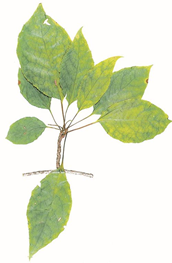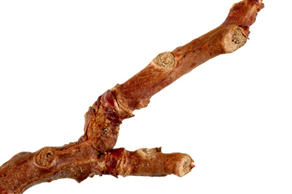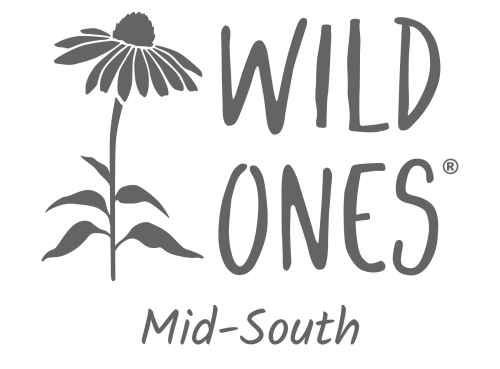
View or download the PDF by clicking here.
Written by Julia Horne:
Schisandra (shiz’-an-dra) glabra is a deciduous woody vine. There are about 25 species of Schisandra in East Asia, but S. glabra is the only species found in America. It is considered native to the southeastern United States (Louisiana, east Arkansas, southwest Tennessee, Mississippi, Alabama, northwest Florida, Georgia, and parts of Kentucky, South Carolina and North Carolina) and northern Mexico (Hidalgo).

Common names include bay starvine (FL, GA, KY), magnolia vine (NC), red starvine (TN) or scarlet woodbine. For many years Schisandras were included in the Magnolia family, but they were eventually moved to their own family, Schisandraceae, which is related to the Illiciaceae (star anise) family.
S. glabra grows in undisturbed moist areas such as mesic wooded bluffs, ravines and stream banks, usually at elevations under 1650 feet. It grows best in shade or partial shade. It is an understory plant which produces roots at internodes and sends up aerial shoots that become climbing vines that either wrap around tree trunks or spread along the ground, reaching lengths of 15-60 feet. New growth is soft and green, which hardens to a reddish-brown bark on stems up to 0.5” diameter. Leaves are simple, ovate-elliptical, about 3-4.5” long and 1.5-2.5” wide with a 1-2” petiole, arranged in a spiral pattern. The vine is monoecious, i.e., both male and female flowers occur as single flowers either at the base of shoots or in the axils of leaves. The flowers have greenish-white sepals and pink to rose-red petals, and appear in May-June. At a glance the flowers look similar to small magnolia blooms. Red berries about 0.375” long appear in late July- August. The plant can be propagated from cuttings, and possibly from seed.

Berries of Schisandra species are used in herbal Chinese medicine, although most commercially available products come from S. chinesis or S. sphenathera. In China they are known as “wu-wei-zi” which means “five-flavor fruits” as they contain sweet, sour, salty, bitter and pungent flavors.
In most of its United States locations S. glabra is a threatened species. Threats mainly come from loss of habitat due to development and forestry practices (including industrial pine plantations), and competition from invasive species such as Japanese honeysuckle. According to the Tennessee Natural Heritage Program Rare Plant List 2016, S. glabra’s TN State status is Threatened (T), its S rank is S2 (see definition below), and its G rank is G3 (see definition below). Tennessee location maps show
occurrences only in Lauderdale, Tipton, Shelby and Rhea counties.
A few populations exist near Memphis: in Meeman-Shelby State Park and Fort Pillow State Park in Tennessee, and in Village Creek State Park and Turkey Ridge Resource Natural Area in Arkansas.

S2: very rare and imperiled within the state, six to twenty occurrences and less than 3000 individuals, or few remaining individuals, or because of some factor(s) making it vulnerable to extirpation in Tennessee.
G3: very rare and local throughout its range or found locally in a restricted range, or, because of other factors, vulnerable to extinction throughout its range. Generally between 21 and 100 occurrences and fewer than 10,000 individuals.
REFERENCES AND IMAGE CREDITS:
Cross, Jacqueline, “Schisandra: Bay Star Vine”, Dave’s Garden, 8/6/2012, www.davesgarden.com
(Accessed: 4/13/21)
Foster, Stephen, “Schisandra: A Rising Star”, Mother Earth Living, www.motherearthliving.com
(Accessed: 4/13/21)
“Schisandra glabra”, Tennessee-Kentucky Plant Atlas, Tennessee Native Plant Society, Kentucky Native
Plant Society & the Kentucky State Nature Preserve, www.tennessee-kentucky.plantatlas.usf.edu
(Accessed: 4/13/21)
“Schisandra glabra”, Vascular Plant Herbarium, UT Herbarium-TENN, www.herbarium.utk.edu
(Accessed: 4/12/21) – Photo Images of leaf and stem
“Schisandra glabra”, Wikipedia, en.wikipedia.org (Accessed: 4/12/21)
“Schisandra glabra”, NatureServe Explorer, NatureServe, 2021, www.explorer.natureserve.org
(Accessed: 4/13/21)
“Schisandra glabra”, North Carolina Extension Gardener Plant Toolbox, NC State Extension,
www.plants.ces.ncsu.edu (Accessed: 4/12/21)
“Schisandra glabra”, Plant Database, Lady Bird Johnson Wildflower Center, 9/25/2014,
www.wildflower.org (Accessed: 4/13/2021) – Photo Images of flowers and berries
Taylor, David, “Bay Starvine”, The Lady-Slipper, No. 20:3, Fall 2005, Kentucky Native Plant Society, pp. 4-
6, www.knps.org (Accessed: 4/13/21)
“Tennessee Natural Heritage Program Rare Plant List”, Division of Natural Areas, Tennessee Department
of Environment and Conservation, 2016, pp. iii-iv, 32, www.tn.gov (Accessed: 4/13/21)
